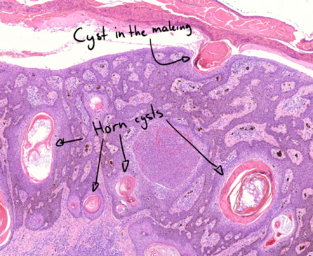43. Seborrhoeic keratosis: Difference between revisions
(Created page with "'''Staining''': HE '''Organ''': Skin '''Description''': A well-circumscribed skin lesion is visible. The stratum corneum is thickened, meaning that there is ''hyperkeratosis''. The cells of the stratum corneum have retained their nuclei, meaning that there is ''parakeratosis''. There are neutrophils in the stratum corneum. These are not related to the disease and are instead the result of the patient scratching the seborrheic keratosis, causing irritation. The basa...") |
No edit summary |
||
| (One intermediate revision by the same user not shown) | |||
| Line 1: | Line 1: | ||
'''Staining''': HE | [[File:Seborrheic keratosis - overview.png|thumb|Overview. Hyperkeratosis is visible.|300x300px]]'''Staining''': HE | ||
'''Organ''': Skin | '''Organ''': Skin | ||
| Line 7: | Line 7: | ||
A well-circumscribed skin lesion is visible. | A well-circumscribed skin lesion is visible. | ||
The stratum corneum is thickened, meaning that there is ''hyperkeratosis''. The cells of the stratum corneum have retained their nuclei, meaning that there is ''parakeratosis''. | The stratum corneum is thickened, meaning that there is ''hyperkeratosis''. The cells of the stratum corneum have retained their nuclei, meaning that there is ''parakeratosis''.[[File:Seborrheic keratosis - neutrophils.png|thumb|These are neutrophils and not neutrophilic microabscesses (as in psoriasis)|333x333px]] | ||
There are neutrophils in the stratum corneum. These are not related to the disease and are instead the result of the patient scratching the seborrheic keratosis, causing irritation. | There are neutrophils in the stratum corneum. These are not related to the disease and are instead the result of the patient scratching the seborrheic keratosis, causing irritation. | ||
| Line 13: | Line 13: | ||
The basal layer of the epidermis contains keratin cysts, called ''horn cysts''. These are formed as the stratum corneum invaginates into the cellular layer of the epidermis, which is also visible on the slide. | The basal layer of the epidermis contains keratin cysts, called ''horn cysts''. These are formed as the stratum corneum invaginates into the cellular layer of the epidermis, which is also visible on the slide. | ||
There is acanthosis, which is visible as the presence of dermal cells in small nests inside the epidermis. | There is acanthosis, which is visible as the presence of dermal cells in small nests inside the epidermis.[[File:Seborrheic keratosis - horn cysts.png|thumb|Acanthosis, the disruption of the epidermis, is also visible. Large melanin pigments are also visible, which give the seborrheic keratoses their black colour|313x313px]]'''Diagnosis''': Seborrheic keratosis | ||
'''Diagnosis''': Seborrheic keratosis | |||
'''Causes''': | '''Causes''': | ||
| Line 21: | Line 19: | ||
* Unknown | * Unknown | ||
* Paraneoplastic (Leser-Trelat sign) | * Paraneoplastic (Leser-Trelat sign) | ||
'''Theory''': | '''Theory''': | ||
Sporadic seborrheic keratoses usually appear in elderly persons. If dozens of keratoses appear within a short period of time, it is a paraneoplastic syndrome called Leser-Trelat sign. This suggests an internal cancer, most commonly a <abbr>GI</abbr> tract carcinoma. | Sporadic seborrheic keratoses usually appear in elderly persons. If dozens of keratoses appear within a short period of time, it is a paraneoplastic syndrome called Leser-Trelat sign. This suggests an internal cancer, most commonly a <abbr>GI</abbr> tract carcinoma. | ||
[[Category:Pathology 2 - Histopathology slides]] | [[Category:Pathology 2 - Histopathology slides]] | ||
Latest revision as of 14:45, 7 July 2024

Staining: HE
Organ: Skin
Description:
A well-circumscribed skin lesion is visible.
The stratum corneum is thickened, meaning that there is hyperkeratosis. The cells of the stratum corneum have retained their nuclei, meaning that there is parakeratosis.

There are neutrophils in the stratum corneum. These are not related to the disease and are instead the result of the patient scratching the seborrheic keratosis, causing irritation.
The basal layer of the epidermis contains keratin cysts, called horn cysts. These are formed as the stratum corneum invaginates into the cellular layer of the epidermis, which is also visible on the slide.
There is acanthosis, which is visible as the presence of dermal cells in small nests inside the epidermis.

Diagnosis: Seborrheic keratosis
Causes:
- Unknown
- Paraneoplastic (Leser-Trelat sign)
Theory:
Sporadic seborrheic keratoses usually appear in elderly persons. If dozens of keratoses appear within a short period of time, it is a paraneoplastic syndrome called Leser-Trelat sign. This suggests an internal cancer, most commonly a GI tract carcinoma.
